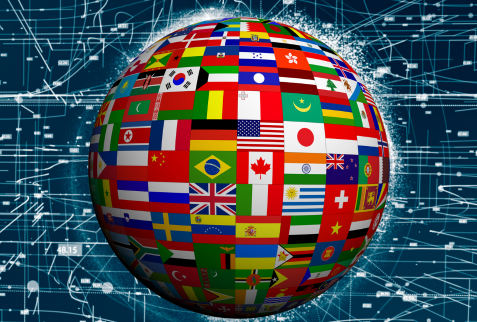Sovereign AI, Identity, and Cyber Compliance
IIS Executive Insights Cyber Expert: David Piesse, CRO, Cymar
Click here to read David Piesse's bio
View More Articles Like This >
“The capacity of a given country to understand, muster, and develop AI systems, while retaining control, agency and, ultimately, self-determination over such systems.” -- UN Internet Governance Forum (IGF) Data and Artificial Intelligence Governance Coalition’s definition of “sovereign AI” [i]
“The AI factory will become the bedrock of modern economies across the world.” -- NVIDIA founder and CEO Jensen Huang [ii]
Glossary
AI factory—A specialized computing infrastructure designed to create value from data by managing the entire AI life cycle, producing measurable intelligence [iii].
Agentic AI—The combination of AI agents, automation, knowledge, and process orchestration of dynamic, complex processes with minimal human oversight.
Artificial Intelligence (AI)—Machines that mimic human cognitive processes, enabling them to perform tasks that typically require human intelligence.
Data sovereignty—A country’s legal jurisdiction over all data generated within its boundary.
Decentralized identifiers (DIDs)— A type of identifier that enables verifiable identity of a person, organization, or data model, as determined by a controller.
Digital sovereignty—The assertion of state control over information flows.
Generative pretrained transformers (GPT)—Generate human-like text based on training data that can learn from vast amounts of data.
Generative AI—A subfield of AI using generative models to produce text, images, videos, or other forms of data. The models learn the underlying patterns and structures of training data and use them to produce new data content based on the input.
Graphics processing unit (GPU)— A specialized electronic chip well suited to AI.
Hyperscalers—Amazon, Meta, Alphabet, and Microsoft; big technology companies.
Large language models (LLM)— A type of machine learning model designed for natural language processing tasks such as language generation and text handling.
Latency – The time delay between input and output.
Key performance indicators (KPI)— Power, water, inference, latency, open source.
Operational technology (OT)— The hardware and software that monitors/controls devices.
Self-sovereign identity (SSI)—Individuals own and control their digital identities.
Sovereign cloud—A cloud computing environment that stores nation data locally.
Sovereign AI—A nation’s independent control over AI systems, data, and infrastructure.
Telcos—Telecommunication companies proving backbone to nations.
Tensor processing unit (TPU)— Unit for AI machine learning acceleration developed by Google.
Synopsis
The global rise of AI, both generative and agentic, has captured government attention in an unprecedented manner with an exponential technology. Sovereign AI has emerged as a critical and competitive path as nations aim to control AI technology capabilities, covering national security, economic growth, cultural preservation, governance, energy production, and data sovereignty for the privacy and protection of citizens. No nation is exempt.
Sovereignty is supreme authority within a territory, including a Westphalian state system [iv] representing the shift of political authority from medieval practices to modern sovereign states using non-intervention and international law. Global digitization has disrupted traditional state sovereignty, blurring physical borders.
Sovereignty may not equate to overall authority, as in the EU region. The year 2020 saw a regression to monarchic interpretations of sovereignty in some nations. For the information and communication sector, there is a transposition around data sovereignty (a nation’s legal jurisdiction over data generated within its boundaries) and digital sovereignty (the state control over digital information flows). Some data sovereignty laws, such as the EU General Data Protection Regulations (GDPR),[v] have extraterritorial application on data processing relating to any citizen within their jurisdiction.
Sovereignty is continually challenged and reinterpreted, in conjunction with a post-Westphalian technology world. Sovereign AI is a nation’s capability to apply AI using its own infrastructure, workforce, and business networks, harnessing and processing its own data to build AI locally rather than relying on external foreign entities.
No nation wants to be left behind in the AI era. This paper looks at what might emerge as sovereign AI takes hold.
Overview
The following diagram indicates the overall sovereign AI high-level profile which links core data infrastructure to supporting layers of connectivity and energy systems. Strategic autonomy [vi] is the overall aim of sovereign AI, leading to mitigation of existential risk.
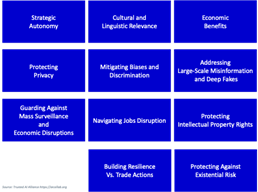
Source: Trusted AI Alliance [vii]
Nations are developing, controlling, and integrating AI technologies within their own ecosystems. According to world trade sources, AI could add as much as $16 trillion to global GDP by 2032, doubling that growth over the next decade [viii].
With the AI market estimated to exceed $1.5 trillion by 2030 [ix], technological sovereignty is a major strategic issue. The following chart from Gartner shows the positioning of sovereign AI in the hype cycle.
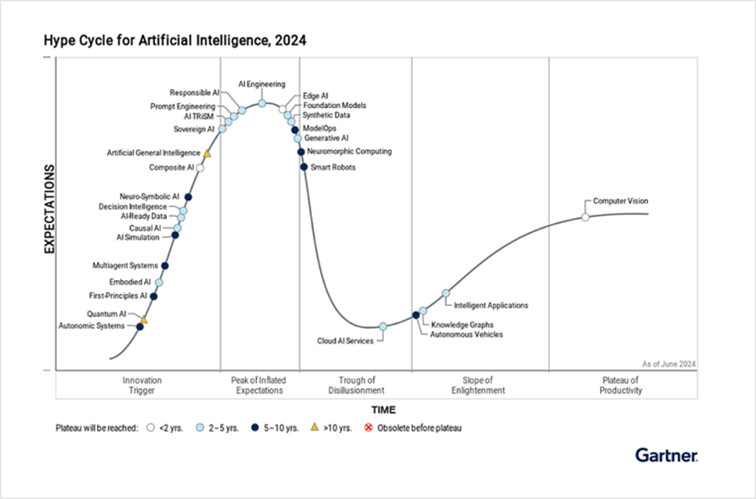
Source: Gartner
Sovereign AI is founded on a robust digital infrastructure comprised of modern data centres with advanced semiconductor computing capabilities, generating and analysing large volumes of data and stored locally within national borders. A skilled workforce is needed so education curricula must include AI, and governments must stimulate AI adoption across business with growth fund incentives.
A regulatory framework is required surrounding privacy, transparency, data protection, cybersecurity, and the ethical use of AI. This doesn’t mean digital isolation as international cooperation and collaboration between nations is paramount for data sharing for energy, healthcare, climate, and quantum computing.
The national global imperative to invest in sovereign AI capabilities has risen with the adoption of generative AI, which changes the nature of work by using AI-powered agents. Sovereign AI encompasses both physical (robotics) and data infrastructures. The latter includes sovereign foundation models, such as large language models (LLMs) developed by local teams and trained on local datasets, promoting inclusiveness with specific dialects, cultures, and practices.
Sovereign AI helps nations with energy sustainability. Next-generation data centres are AI factories, handling computationally intensive tasks where data is ingested and outputs intelligence inference. Nations are building domestic computing capacity by operating sovereign clouds in collaboration with state-owned telco utilities or sponsoring local cloud providers to offer a shared AI computing platform for public and private-sector usage.
Sovereign AI is relatively new, and nations must create AI models within government and/or private companies. Leaders of nations investing in AI initiatives must prepare for impacts on data sovereignty. This goes beyond regulatory compliance into strategic independence by de-risking dependency on external AI providers, which reflect the interests of a few entities over ethical frameworks of many nations.
Governments are ensuring that national values are integrated into AI systems like generative pretrained transformers (GPTs) and LLMs. Unilateral policy actions by some nations to restrict access to advanced AI systems has catalysed sovereign AI, resulting in national AI policy initiatives emerging across Europe, Asia, and North America, reflecting a global trend.
When determining sovereign value propositions, policymakers can assess their domicile’s infrastructure and capabilities against key performance indicators (KPIs) ’s needed for creation and maintenance of sovereign AI: namely access to power, water, hardware, talent, inference, and carbon capture. They need to prioritise specific industry sectors and invest and collaborate with technology companies that support local capabilities, plus adopt an open-source code strategy.
Sovereign AI and Inference
AI inference happens when deployed, trained AI models use learned knowledge to make predictions or generate outputs from new data, which is then applied to real-world situations such as recognizing road signs in a self-driving car.
Inference is computationally intensive, and specialized hardware like graphics processing units (GPUs) are used to accelerate the process. Inference outcomes can be biased and inaccurate if just based on statistical correlation without factoring in cause and effect. Taking the sovereign LLMs and applying causal inference models and human in-the-loop knowledge leads to sovereign-based agentic AI, which can then be imbued in the local AI agent model for workforce enhancement.
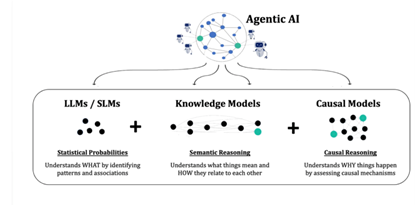
Source: “TheCube Research” [x]
Causal inference decides what assumptions substantiate causal and counterfactual questions from a given type of data, making AI systems smarter by injecting real-world logic and cause-and-effect dynamics into decision making. Traditional AI identifies statistical relationships within large datasets for image recognition, predictive text generation, and language translation, but has limited understanding of the underlying data. It can produce incorrect and even dangerous conclusions for critical decision making.
Causal AI works with traditional and generative AI to answer real-world questions. By combining scientific knowledge and data, causal models can discover valid links; for example, by combining data from several sources to identify factors that cause a medical treatment to be harmful to one patient and beneficial to another. This delivers explainability by querying a model to know how the system arrived at a specific outcome by adopting a human-curated approach to avoid spurious correlations.
Such is the value of sovereign AI as stated by the World Economic Forum [xi] on approaches to healthcare, energy, and climate change, where LLMs capture domain knowledge that can be applied for causal analysis. The intersection of sovereign AI, causality, and quantum computing will leverage the computational power of quantum computers to enhance AI capabilities in drug discovery, materials science, and climate.
Effects of Sovereign AI
Nations seeking to attract investment and aim for technological leadership have made sovereign AI a pivotal issue in international relations and infrastructure development. This will have a disruptive effect on all aspects of business and daily lives. Computational sovereignty directly translates to decision making.
The following diagram from STL Partners breaks down sovereign AI into 3x3 pillars reflecting the high-level base components.

Source: STL Partners [xii]
The effect is transformative, with nations migrating from outsourcing, impacting current outsourcer nations. Enterprise AI-ready data centres embedding energy and connectivity need to be assembled using local partnerships, investment, and regulation to become operational and maintain data sovereignty.
Sovereign AI covers the entire AI life cycle, from raw data acquisition, harmonization, model training, deployment, inference, to overall governance. Nations curate their own workforce and business networks to be resilient against geopolitical fragmentation such as supply chain dependencies or political sanctions, denying access to latest cloud services or GPUs.
Regional sovereign cloud expansion leads to management and integrity of data and metadata in the cloud, creating identity monitoring not only for people, but data and devices as well. This can have regional cross-regulatory purposes, preventing global data exchange. Computation will be brought to the data and infrastructure instead of shipping data to centralized locations. The sovereignty model must utilize trusted service partners that respect boundaries, so leaders know the situational awareness of data both upstream and downstream in the value chain.
Nation partnerships (such as France and the United Arab Emirates) offer KPIs of sovereign AI to stimulate more investment into local data centre markets. Partnerships outside of a nation for sovereign purposes can be a geopolitical high-risk strategy. Local telcos will compete with hyperscalers, and nations may obtain sovereign AI skills by acquisition.
Nations without the capability to build sovereign AI can take advantage of “centralized training with decentralized inference,” where AI model training is conducted in GPU central clusters, but using edge devices (e.g., smart phones) and/or lower-cost CPUs for inference (answering queries). This doesn’t address concerns regarding export restrictions and ethics but does address data sovereignty.
Use of training algorithms requiring less power computation can achieve results comparable to large-scale systems. Currently the ability to create large-scale AI systems only exists in a few wealthy and technologically sophisticated nations.
Nations must guard against economic disruptions arising from ungoverned deployment of AI technology, including job displacement caused by AI-driven automation. GPTs take over human tasks as AI agentic capabilities are a force multiplier for human labour, enhancing productivity. Protecting IP rights against exploitation by foreign entities is paramount. Currently individuals employed by private companies decide the values, ethics, and principals embedded in AI systems such as ChatGPT (Open AI) [xiii] or Gemini (Google) [xiv].
Current Landscape
The global leaders in sovereign AI are the United States and China. The U.S. has built thousands of data centres, being energy rich, investment strong, and with resident engineering talent, favourable regulation, and domiciling leading telcos like Verizon, IT-Mobile, plus Cisco and NVIDIA with the largest LLM companies such as Open AI.
In China, the "Eastern Data and Western Computing" project involves plans to construct eight major data-centre hubs [xv].
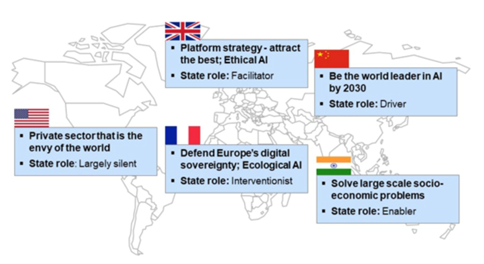
Source: London Business School
Telcos have sovereign AI factory solution blueprints for large-scale AI and agentic deployments. From the geopolitical landscape, North American governments are deploying sovereign AI with promises of economic growth and efficiency gains in public services.
France leads the European AI model development with Mistral AI [xvi] for European cloud and regulatory initiatives. The U.S. aims to achieve global dominance in AI and set global AI standards; they must innovate quickly to maintain AI infrastructure and the energy to power it. China is well advanced in AI due to massive government-level investments.
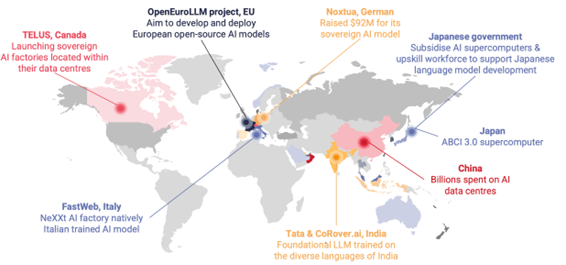
Source: STL Partners
The Middle East (ME) plays a catalytic role in sovereign AI development. G42 [xvii] from the UAE is a sovereign AI player with partnerships with Microsoft, OpenAI, NVIDIA, Oracle, IBM, and Mistral AI. For Africa, AI technologies may undermine national sovereignty, Pan-Africanism values, and civil liberties. However, sovereign AI must not be conflated with individual rights as some aspects of sovereign AI, including value alignment and legality, can overlap with autonomy and self-determination.
AI skill sets are low in emerging nations, but UAE offers aid to many nations to help build data centres to address agriculture, manufacturing, or government verticals. Partnerships are needed with telcos for cloud connections and energy companies for electricity, depending on the location of internet exchange points and subsea cable hubs. Large enterprises will need low latency and high trust computing aligning with nearshoring of infrastructure to nearby nations.
The ME, especially Saudi Arabia, has sovereignty regulations forcing companies to invest in local data centre infrastructure. The ME has strong AI market drivers such as investment, low energy costs, and land power; while lack of technical skills is a weakness, they can pay well to engage talent. Saudi Arabia offers services to host sovereign workloads governed by the laws of the guest nations.
Saudi Arabia's state-backed AI firm Humain is a global AI player, having already achieved $27 billion in infrastructure build-out investment as well as a $10 billion venture fund [xviii] , with partnerships underway with U.S. tech firms like Open AI and NVIDIA. The ME is well positioned as a digital traffic crossroads hub between Asia and Europe to meet AI hyperscale workload demand. The UAE advances AI initiatives through a dedicated research institute with development of a LLM called Falcon AI [xix].
In the U.S., the CHIPS and Science Act [xx] regulated the need to produce more semiconductor chips. The U.S.-saturated market causes bottlenecks on secure grid connections in demand zones but provides opportunities to host infrastructure for large-scale service providers closer to U.S. AI developments.
The fact that environmental, social, and governance (ESG) regulation is recently moving away from sustainability has benefits for data centre operations, but private equity still backs sustainability. Nations can partner to enhance collective AI sovereignty and cross-border collaboration by combining KPIs. Collectively they meet the AI gold standard to host data domestically but need government signaling to adhere to common legislative principles. Early adopters for sovereign AI are governments and regulated industries such as financial services.
There is systemic risk to the economy if connectivity goes down, affecting the banking sector. The sovereign AI solutions provided by the hyperscalers can be a concern from other regions such as EU, as the U.S. CLOUD Act [xxi] indicates extraterritorial data sovereignty. In the EU there is increasing personal liability over data beyond company-level liability, and boards must have control over their data architectures and data locality.
Sovereign AI is not only data centre infrastructure equipped with GPUs, but embedded software applications (LLMs). Canada will invest $2 billion over five years in the Canadian Sovereign AI Compute Strategy [xxii]. Telus is building two telco-led sovereign AI factories in Canada, deploying NVIDIA’s supercomputers in each facility, as part of a $70 billion, five-year investment plan. Telus sees revenue opportunities as providing GPU-as-a-service and delivering additional services on top of the basic compute with enterprise platforms.
Telcos can offer sovereignty-as-a-service in every product and service with trusted data. LLMs are moving beyond R&D labs into the core of governance. The EU has pledged €1 billion annually through 2027 [xxiii] to strengthen AI ecosystems. The Brazilian government has invested $4.2 billion in national AI programs, and $200 million for the creation of a national LLM [xxiv]. The Indian government is building a large-scale AI infrastructure powered by NVIDIA chips [xxv] to develop an LLM trained on the nation’s diverse languages.
Bell Canada committed to building 500 megawatts of hydro-electric-powered AI compute capacity across six data centre facilities [xxvi] in partnership with AI inference provider Groq. Deutsche Telekom is offering NVIDIA H100 tensor core processors as a service from its sovereign Open Telekom Cloud [xxvii] data centres across Europe. Telkom Indonesia [xxviii] has partnered with IBM to deliver sovereign AI services to businesses, and policymakers of super-national groupings (e.g., EU, African Union, Gulf Cooperation Council [GCC], Association of Southeast Asian Nations [ASEAN], South Asian Association for Regional Cooperation [SAARC]) can develop AI capability outside of exclusive control of mostly U.S.-based big tech companies.
The U.S. is working with OpenAI and Microsoft to advance the Stargate Project, [xxix] which invests $500 billion into AI development over the next four years.
In 2024, Denmark launched the Gefion supercomputer [xxx] to use AI to accelerate innovation, ranging from quantum computing and drug discovery to the transition to green energy. With the increased computing power, Denmark has commenced sovereign AI objectives. At the AI Action Summit in February 2025, France announced building supporting data centres and infrastructure to funding a government-owned AI model. InvestAI, [xxxi] a €200 billion project to build AI (giga) factories across the EU. Microsoft announced a $700 billion AI investment in Poland. [xxxii]
Challenges of Sovereign AI
Benefits of sovereign AI are clear, but the road ahead is full of challenges and mitigation.
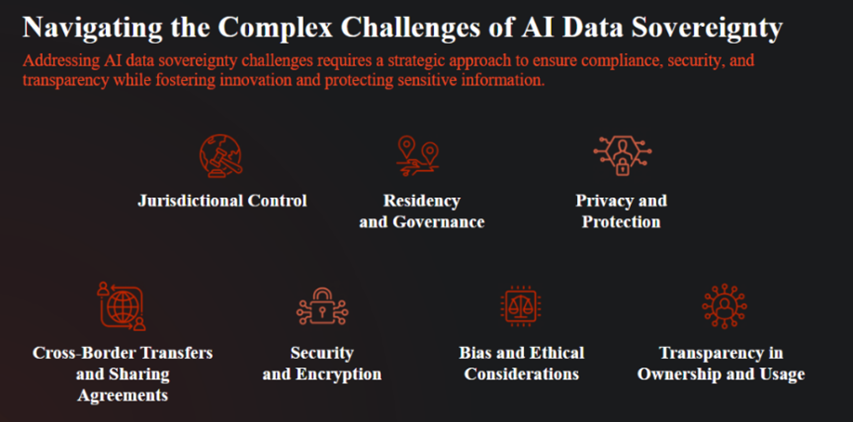
Source: DDN [xxxiii]
Risk mitigation needs resilience to digital supply chain problems, maintaining control on IP, critical infrastructure, and customer data, and maintaining liability protection within regulation. Sovereign AI architecture needs to reduce cloud inference latency tenfold and improve performance on large datasets. Predicting computation time and application program interface (API) calls for the total cost of AI implementation when training AI models in a cloud-based environment, and is a challenge due to many variables and unpredictable pricing.
In governments, healthcare critical information service providers are asking for compliant out-of-the-box data and AI solutions with reference architecture. Cisco/NVIDIA announced a secure AI factory [xxxiv], pre-validated blueprint reference architecture combining a robust compute portfolio with networking and security, optimized for on-premise and edge AI workloads. Nations creating their own AI models must have investment capabilities and infrastructure in place to support high energy needs, such as the GPU clusters for the parallel processing required to accelerate AI training, and advanced network connectivity.
Security and compliance are the biggest challenges when moving an AI model from development to production and has to involve the full technical stack, not just endpoints. The data must be fully harmonised for AI-ready workloads. AI sovereignty and secure infrastructure are a foundation by design and not a reconsideration.
Lessons for how nations should address AI can be drawn from other strategic technologies such as space launch that impacted national investments into long-range deep tech ecosystems. Political leaders see the importance of dedicating financial resources and regulatory changes to accommodate capability. Unlike a space launch, AI is invasive to citizens’ privacy. A global trade war could result in restrictions on AI technology exports, limiting access to critical AI resources and hindering technological advancement and economic growth in affected countries. Sovereign AI capabilities reduce dependence on foreign AI technologies and mitigate the impact of trade and geopolitical restrictions.
Developing economic regions such as sub-Saharan Africa built mobile networks, bypassing high-bandwidth fibre optic telecommunication systems. However, this limits their ability to accommodate the information bandwidths to and from data centres that AI applications require, causing reliance on long-distance communication, with inherent latency issues. The alternative of communications via satellite may be more costly and restrictive to the last mile.
There is no AI without energy, but AI can transform the energy sector. Affordable, reliable, and sustainable electricity supply is crucial for AI development, and nations that deliver the energy needed at speed and scale will profit. A broader challenge that AI could face is resistance from a lack of social trust, such as safety concerns or impacts on finances. Social trust may also be challenged if the choice of individual consumers to opt in or out is not preserved in AI applications. Finally, resource factors will influence sovereign AI, including infrastructure constraints such as energy production capacity and availability of water.
Data Sovereignty
Data is subject to the laws and governance of the nation where it’s collected. This is critical for maintaining national control over data resources and protecting the privacy and rights of citizens. Data collected within a country must be stored on servers physically located within national borders, thus protecting data from foreign jurisdictions by implementing stringent regulations to govern data collection, storage, and processing within the country ensuring compliance. This includes implementing strong authentication mechanisms, encryption protocols, and role-based access controls to safeguard data sovereignty.
Digital sovereignty addresses protection of data information flows, preservation of national security, and local economic opportunity. These regulations have extraterritorial application applying to the global digital footprint of populations. Sovereignty is an organizing matter for nations, not individuals or communities, and is a global digital and political concept. Sovereign AI will enable nations to utilize wholesale AI offerings on the market.
Regulatory Issues
Data localization and AI governance laws are expanding globally, with over 30 national AI regulations in stages of implementation motivated by technological independence [xxxv]. Nations must build a sovereign AI environment that is secure, explainable, and compliant by design; otherwise, they risk failing to meet the regional data sovereignty regulations using public cloud, where there are strict data laws. Coregulation models are effective, where legislation outlines the outcomes but leaves space for industries to achieve compliance. Leveraging best practices from leading organizations and collaborating with standard-setting organizations such as ISO, IEEE, and IEC, and organisations like NIST, ensures regulations align with global standards and reflect the latest advancements and consensus in AI governance to streamline the development of effective AI regulations.
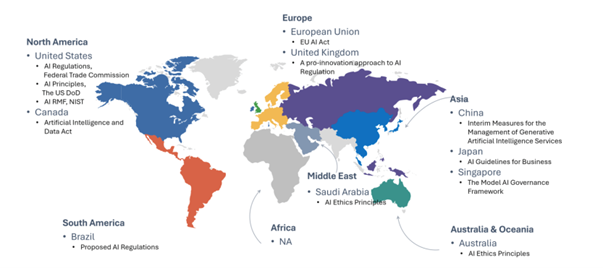
Source: White and Case [xxxvi]
Adopting a risk-based approach to regulation ensures that regulatory oversight is proportional to the risks associated with AI applications where those at high risk, such as finance, public safety, and healthcare would include more stringent regulations. Implementing regulatory sandboxes allows innovation in a controlled environment to test business models under regulatory oversight, ensuring compliance with ethical and safety standards before wider deployment, with regulatory authorities deriving education from industry players.
The EU AI Act [xxxvii] is the first global risk-based AI regulatory framework. This regulation shapes how AI algorithmic systems are built and used within national borders, particularly nations that plan to deploy high-risk AI systems like facial recognition or healthcare.
The EU Data Act [xxxviii] shapes the framework for sovereign AI, improving data accessibility and governance and making device data available to manufacturers and third parties. It regulates fair contract terms for data sharing to enable switching between cloud providers to allow access to data for AI training and development. It also regulates the terms under which organisations can avoid lock-in with a particular cloud service provider.
The NIS2 Directive [xxxix] improves overall EU cyber resilience by setting common cybersecurity standards. The act applies to critical infrastructure sectors including energy, transport, and digital services, and mandates that entities adopt stronger cybersecurity measures and report major incidents to authorities.
The Digital Operational Resilience Act (DORA) [xl] impacts sovereign AI by establishing robust requirements for operational resilience, cybersecurity, and risk management within data infrastructures of the financial industry and across supply chains. As sovereign AI systems penetrate financial services, DORA ensures they are resilient to cyber threats and operational disruptions and places KPIs on the downstream supply chain of the financial industry, ranging from operational resilience, transparency, and performance monitoring. By enforcing standardized risk management protocols and incident reporting requirements, this complements the EU AI act by safeguarding the stability and security of critical AI-driven services delivered to the financial industry across different service providers.
Data Integrity
Implementing data validation and verification processes ensures data is accurate, complete, and reliable. This includes cross-referencing data sources, using hash functions, and employing data quality assessment tools.

Source: E-Estonia[xli]
Maintaining an audit trail of sovereign data provenance, including the origin, history, and transformations applied to the data and utilizing tamper-evident technologies such as blockchain, is required to protect data integrity. These technologies provide a secure and immutable record of data transactions, making it difficult for unauthorized modifications to go undetected. Deploying automated data cleaning tools to identify and correct errors, inconsistencies, and anomalies in datasets helps maintain high-data quality and reduces the risk of inaccuracies affecting AI outcomes. Conducting regular audits and reviews of data management practices can ensure ongoing compliance with data authenticity standards. Implementing robust, informed consent mechanisms ensures that individuals are aware of how data will be collected, used, and shared.
Data Centre Evolution: AI Factories
Sovereign AI is the future of data centres, encompassing inference platforms and data sovereignty. The data centre is the core hosting facility of AI training and supporting infrastructure for connectivity of energy grid, telcos, and land—all integral for sovereign AI adoption. Large, modern data centres contain thousands of individual computers stacked vertically in large racks. Power availability is a key bottleneck to building new data centres.
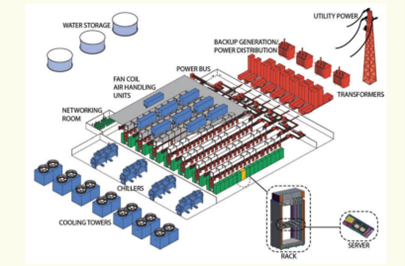
Source: Contribution Physics [xlii]
Data centre builders respond to limited power availability by exploring alternative locations and energy sources. Historically, data centres are built near major sources of demand, such as large metro areas or major internet infrastructure to reduce latency. These facilities prioritise reliability, energy efficiency, and low latency for video streaming and web hosting. AI training is less latency sensitive, leading to the development of data centres outside existing clusters. For autonomous vehicles, models run on hardware in the car, as the latency tolerance is zero because of instantaneous decision making. Conversely, generative AI model queries have higher latency tolerance, allowing the data centres processing these queries to be more distributed away from saturated urban areas as shown below.

Source: IEA [xliii]
Training large AI models is computationally intensive, compensated by more efficient chip technology development. Traditional data centres aren’t suited for AI workloads, resulting in specific AI data centres supplying power to individual chip racks and removing power when it turns into heat. This means cooling is moving from air conditioning to liquid cooling.
Fluid needs to be piped directly around a computer chip, as for Google’s TPUs. Eventually entire computers will be immersed in a heat-conducting fluid. The enormous power consumption of these AI-specific data centres will require constructing new electrical infrastructure, such as transmission lines, substations, and firm sources of low-carbon power, to meet tech companies' climate goals. There is a challenge with large LLM models so smaller, multi-agent models are being used. NVIDIA’s GPU dominance is propelled by a highly developed software stack using edge computing to address hardware bottlenecks.
Land is crucial for building data centres, requiring investment from public and private sectors. AI-ready data centers must scale with total resiliency. Synergy Research says by 2029, hyperscalers (or telcos) will account for over 60 % of total data centre capacity, while on-premises capacity will fall to 20%, with colocation facilities making up the rest. [xliv]
Sovereign AI infrastructure is more than fast servers and GPUs; it’s a full stack of systems that store, organize, move, and activate data from the edge to the cloud to the data centre, making underlying data accessible, trusted, and governable. Sovereign clouds are essential, emerging in 2019 with early adopter nations partnering with hyperscalers and telcos.
Data centres are growing in the Southeast Asia-5 markets, led by Malaysia, with Thailand, Vietnam, Indonesia, and Philippines, accelerated by the 2019 Singapore data centre moratorium, now lifted, which redirected investment to neighbouring countries [xlv]. Malaysia officially launched the Strategic Artificial Intelligence (AI) Infrastructure in May 2025, becoming the first in the Asia region to activate a sovereign, full-stack AI ecosystem run in Malaysia with AI agents developed by Malaysians.[xlvi]
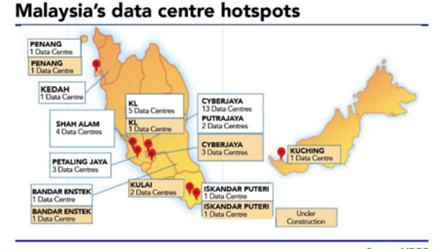
Source: MDEC [xlvii]
In 2009, Sun Microsystems, Microsoft, IBM, and Google launched 20’ x 8’shipping container data centres which are transportable can be buried underground with sensors and can withstand earthquakes.

Source: SUN [xlviii]
2021 saw commercial underwater data centres (UDCs) emerge, which are watertight, container-like pods submerged in the ocean using cold seawater for cooling. China has launched the world’s first commercial-scale facility off Hainan, hosting hundreds of servers and capable of training large AI models every day [xlix] with high compute density and vast amounts of storage. Over 50% of the global population lives within 120 miles of the coast. Underwater data centres offer low-latency edge computing to billions of users, matching or exceeding the global cloud capacity of current land-based systems.
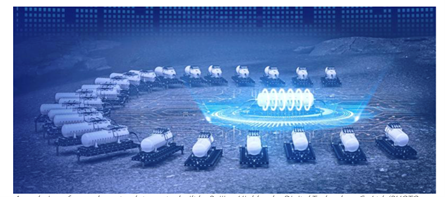
Source: China Daily
Energy Requirements
The operating costs for AI systems are driven by energy consumption for computation and cooling, both accounting for half of the total energy cost. The global data centre consumption of electricity (excluding cryptocurrencies) is 1.0 percent to 1.5 percent of the world total, according to the International Energy Agency (IEA) [l]. Sovereign AI changes data centres' energy demands. Barclays Research, based on utilities forward-looking supply contracts, says annual demand to power data centres in the U.S. will grow by a range of 14 percent to 21 percent every year to 2030 [li], roughly equivalent to 13 percent of current U.S. electricity demand. AI data centres will provide a larger global electricity demand than the sums currently factored into net-zero targets.
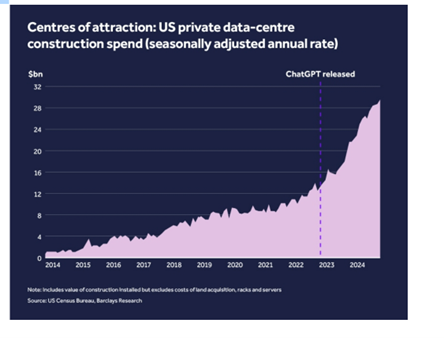
Source: Barclays Research
The hyperscalers are the biggest buyers of power under long-term clean-energy contracts, according to Bloomberg New Energy Finance [lii] and as the benchmark growth diagram shows here, they’re growing very fast, requiring constantly available sources of power and becoming market driven on demand by grid operators.
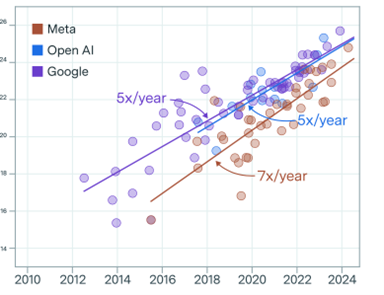
Source: Epoch AI
Renewable energy can’t meet the electricity demand for AI, so fossil fuel energy is required. However, eventually nuclear power will provide stable, carbon-free electricity, reducing overall decarbonisation costs. Small modular reactors (SMRs) can provide low- carbon electricity to power data centres. Amazon invested in nuclear developer X-energy[liii] to deploy SMRs. Microsoft, with Abu Dhabi-based AI company G42, is investing in a data centre powered by geothermal energy in Kenya [liv], and signed a geothermal PPA in New Zealand [lv].
Renewables and natural gas take the lead in meeting data centre electricity demand.Half of global growth in data centre demand is met by renewables, supported by storage and the electricity grid. Nuclear power will contribute additional generation to meet data centre demand, notably in China, Japan, and the U.S., with the first SMRs coming online there around 2030.
According to the IEA, [lvi] AI data centres consume as much electricity as 100,000 households, but those under construction today will consume 20 times more. Global investment in data centres has doubled since 2022, amounting to $500 billion in 2024. The U.S. share of global data centre electricity consumption in 2024 was 45 percent, China 25 percent, and Europe 15 percent, with global demand growing at 12 percent per year, four times faster than total electricity consumption. AI data centres consume as much electricity as power-intensive factories, but they are geographically concentrated, with global data centre capacity existing in clusters in fixed locations.
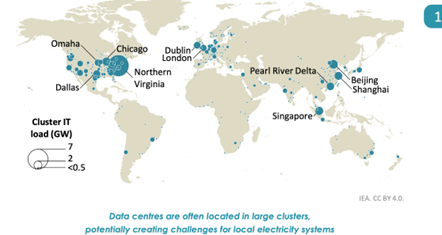
Source: IEA
Because of this clustering, electricity grids are under strain, and many planned data centre projects are delayed, waiting for grid connection, new transmission lines, or transformers. New data centres must be located in areas of high power and grid availability.
On the flip side, energy companies deploy AI to optimise energy, mineral supply, electricity generation, transmission, and consumption. The oil and gas industry uses AI to optimise exploration, production, maintenance, pre-drilling uncertainty, and safety. AI can help balance electricity networks and improve the forecasting and integration of renewable energy generation, reducing curtailment and emissions. AI-based fault detection can help identify and pinpoint grid faults, reducing outage durations by 30% to 50%. Smart meter sensors in data centres can reduce electricity grid usage and increase capacity of transmission lines.

Source: Guardtime
Even before generative AI was introduced at scale, nations struggled to meet rising energy demands. Building new power generation capacity has a long lead time and requires high capital investment. AI demand exceeds the speed that the energy grid can be upgraded.
Australia is building sovereign AI capability but requires investment in energy infrastructure to power the data centres to avoid importing capability through hyperscalers, ceding control and sovereignty. They also risk building data centres on grids that are not equipped to support needs and must prevent energy bottlenecks from constraining sovereign AI capacity.
Both private sector and government need to work together to secure a pipeline of semiconductor chips from global manufacturers to ensure access to latest technology. Liquid cooling reduces power consumption by 90% compared to traditional air-based systems in order to manage the intense heat generated by densely packed, high-performance AI chips. This requires vast quantities of fresh water. Australia can co-locate data centres with renewable energy infrastructure. Projects like Snowy Hydro 2.0 [lvii] provide access to water, energy, and grid infrastructure to help meet data centre demand. Positioning centres near wind/solar farms offers access to use clean power, reducing additional infrastructure need and effective where latency is crucial or where sensitive data must be kept closer to its source.
Climate Change
Data centre carbon footprint is an issue: A single query to a generative AI model consumes as much as a bottle of water for cooling. Google’s carbon emissions, for example, have increased by 50 percent since 2019 due to AI, according to its 2024 environmental impact report. [lviii]
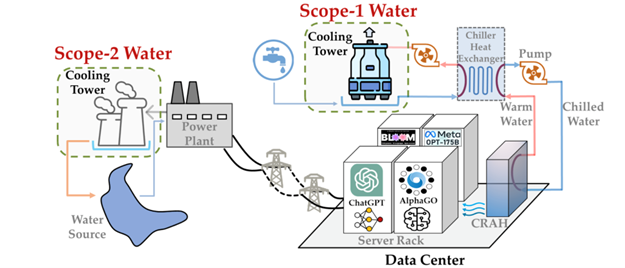
Source: OECD.AI [lix]
The production of GPUs, TPUs, and other hardware components involves significant carbon emissions due to manufacturing processes and raw material extraction. The operational phase, i.e., the energy consumed during training and inference, is the primary contributor to the carbon footprint of AI. Technology companies look at green data centres and purchase carbon removal credits or forward purchase commitments, with a mixed portfolio of technology-based removals (such as direct air carbon capture and storage) and nature-based solutions (such as reforestation projects). Microsoft plans to be carbon negative by 2030, and to eliminate by 2050 all carbon emissions it has produced since 1975 [lx]. Google committed to becoming net zero in 2030 [lxi], and contracted for over $100 million worth of carbon removal. The recent rise of AI and the energy demands may force a rethink of those targets.
Cybersecurity
Data centres are oxygen to digital life in an AI era. Governments declare data centres as critical infrastructure in the same bracket as water and energy utilities, healthcare, telecommunications, and cloud operators. Data centres store high-value data, making them a target for cybercriminals and nation-state threat actors, where an outage can cause huge disruption. In the cloud the data is the perimeter, and everyone is an insider threat, so identity is key. Data centres also have a supply chain of hardware and software, where a breach can compromise security. Cybersecurity is crucial for sovereign data centres to protect data within a nation's borders from threats and foreign surveillance.
Sovereign AI has cybersecurity issues at the sovereign data level, data centre infrastructure, supply chain, cloud providers, and at the electric grid level. The use of Bring Your Own Key (BYOK) [lxii] enables nations to manage their own encryption keys, giving them full control and reducing reliance on the cloud provider's key management system, in line with NIST cybersecurity triangle.

Source: NIST[lxiii]
As energy systems become electrified, integrated, and connected, vulnerability to cyberattacks increases. AI-enabled cybersecurity features such as enhanced threat detection can help secure energy systems. Intrusions by malicious actors have exposed critical infrastructure to disruptions, with implications for the economy, safety, and geopolitical tensions. There have been numerous cyberattacks on energy systems as shown in the chart below (source: author research), highlighting the vulnerability of critical infrastructure.
| 2012 | Saudi Arabia Aramco ransomware attack |
| 2015 | Blackout in Ukraine affecting 225,000 people |
| 2020 | A malware attack on Mumbai’s electrical grid that led blackouts in India [lxiv] |
| 2021 | Cyber ransom attack on oil pipeline in the Eastern U.S. |
| 2024 | Gas and electricity utilities face 1,500 cyberattacks per week [lxv] |
| 2025 | The David-Besse nuclear power station in the U.S. shut down by worm |
| 2025 | Iberian Peninsula Blackout, cause unknown |
Source: NIST [lxvi]
AI is a force multiplier in both directions, enhancing threat detection defence but also empowering adversaries with tools for sophisticated attacks. Malicious actors have used generative AI tools for reconnaissance to target organisations, obtain deeper access to target networks, and for malicious scripting and evasion techniques. A new cyber threat AI brings is data model poisoning, which stresses the importance of data integrity for AI.
Intrusion Detection and Prevention Systems (IDPS) monitor network traffic for malicious activity to prevent intrusions and get critical system activities, to detect and respond to threats. Using automated vulnerability scanning tools to continuously assess the security posture of AI infrastructure using applications such as Astragar[lxvii] and CrowdStrike [lxviii] for cyber risk quantification are needed for exposure and cyber insurance. By investing in sovereign AI, countries reduce reliance on external AI APIs that introduce supply chain vulnerabilities and cyber risk back doors that transcend borders. Data often crosses borders, making it vulnerable to unauthorized access and compliance violations. Sovereign AI ensures that sensitive cybersecurity data remains within secure boundaries.
Cybersecurity of cloud environments where AI workloads are running is key, but a critical risk layer lies in the physical infrastructure (operational technology, or OT) that powers and supports AI data centres. OT systems are often excluded from traditional cybersecurity frameworks, even though the cyber risk is high as in the IT software environment. An OT breach can trigger systemic failure, disabling cooling, overload circuits, or initiating fire suppression protocols. Unlike software exploits, which affect data confidentiality or availability, attacks on physical systems threaten immediate catastrophic operational disruption. Many new data centres are co-located with energy production hubs, hydroelectric dams, nuclear plants, or large-scale solar arrays. The convergence of IT, OT, and physical systems makes it increasingly likely that a compromise in one domain will pivot into another. When security is not baked in, the cost is enormous, with data exposure, IP leakage, and model poisoning going undetected.
Rethinking the Supply Chain
The world’s reliance on semiconductors has grown because of AI. Natural and manmade disasters have highlighted the fragility of the semiconductor industry global supply chain, which has become an area of national strategic importance, and governments across the world are competing to strengthen their supply chains. Amid this re-risking, Southeast Asia (SEA) has emerged, with a semiconductor ecosystem that has strength throughout the value chain.
AI data centres are a product of complex global supply chains. The machines that make high-end chips is dominated by Europe, actual chip production is concentrated in East Asia, using rare earth components extracted globally as shown below. The U.S. dominates AI model development/deployment alongside China, which has rapid AI growth at the domestic level.
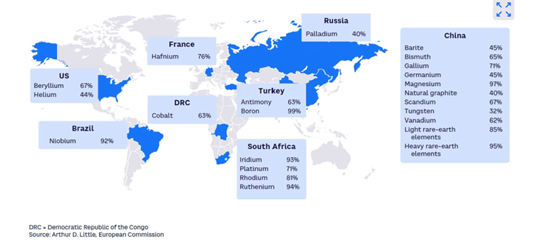
Source: Arthur D Little [lxix]
The building blocks of AI infrastructure are individual semiconductors with billions of transistors, made by lithography machines using light to etch microscopic circuit patterns at scale onto high-purity sand silicon chips. The ultraviolet lithography machines are produced by Advanced Semiconductor Materials Lithography (ASML)[lxx] in the Netherlands.
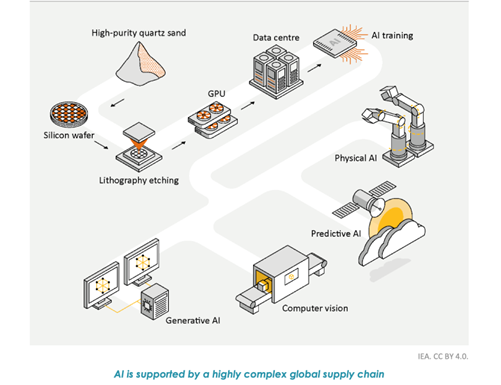
Source: IEA
Traditional computing is dominated by CPUs, but AI computing is built around GPUs, which allow for rapid and energy-efficient parallel processing. Vendors that design the semiconductor chips include NVIDIA, Broadcom, AMD, and Intel, so market leaders among chip designers are based in the U.S. The chips, once designed, are manufactured either by integrated device manufacturers such as Intel, or by foundries such as TSMC [lxxi] and Samsung Foundry, [lxxii] based in Chinese Taipei and Korea, respectively. TSMC had 67 percent share of foundry revenue in 2024 [lxxiii]. Recently China mandated domestic AI chips from Huawei to avoid reliance on NVIDIA [lxxiv], sparking a race with the two leading nations.
The supply chains of AI infrastructure are international even though parts of it are heavily aggregated in certain regions, so supply chain concentration has also raised security concerns.
AI is advancing battery innovation from materials discovery and testing to performance predictions, production optimisation, battery management system optimisation, and end-of-life management, plus mitigating the risk of lithium battery fire.
Business Sector Use of Sovereign AI
Sovereign AI affects all business sectors but there will be early priority on government and regulated financial services. Telcos are the backbone to operating core infrastructure and sovereign clouds protect national interests. NVIDIA leverages the sovereign AI opportunity with multiple telco-led AI factories across five continents[lxxv] with partnerships with Orange, Fastweb, Swisscom, Telefónica, and Telenor Group.
Sovereign cloud capabilities help the healthcare industry adopt real-time AI without compromising data privacy laws. Healthcare is adopting agentic AI to address a shortfall of 10 million workers globally by 2030 [lxxvi]. The global AI healthcare market is projected to reach $187.69 billion by 2030, [lxxvii] with data sovereignty a legal and ethical imperative for patient trust.
Even if cloud providers store healthcare data in a local data centre, backups or metadata may be transferred to data centres in other countries. Hospitals and health systems can run and train AI models and process diagnostic information without transferring data to third-party overseas cloud environments which support edge AI, allowing real-time inference to occur at the point of care. For example, radiology scans can be analysed instantly to flag anomalies, or wearable health data can trigger alerts for early intervention while remaining securely within the hospital’s infrastructure. These platforms can also track changes in patient data over time to identify subtle signs of medical fraud.
In agriculture, AI reshapes the way food is grown and managed, using AI to steer decisions about what gets planted and how crops are managed. As the manufacturing industry becomes fully digitalized, AI has become an enabler, especially in areas like computer vision, digital twins, and robotic automation. GenAI has emerged to understand, interpret, and reason over complex engineering drawings and help engineers with predictive maintenance. The widespread adoption of AI applications across the transport sector could lead to energy savings equivalent to the energy used by 120 million cars [lxxviii]. There is potential for AI-led optimisations in buildings to make heating and cooling systems more carbon efficient and electricity use in buildings more flexible. There is a link between sovereign AI and the tokenisation of real-world assets such as real estate. Registry of property ownership and taxation across borders to ensure land or mineral titles can be made immutable across each jurisdiction by use of blockchain decentralisation, sovereign clouds, and data sovereignty.
Financial Sovereignty
Governance is required over monetary systems within jurisdiction in response to geopolitical and economic shifts that have necessitated maintaining control over national financial systems. Financial sovereignty has been transformed by globalisation and digitalisation. Stablecoins are significant as global reach, permissionless network operation, and function as digital bearer instruments allow them to bypass traditional financial intermediaries and jurisdictional boundaries. They are chiefly in the payments space until they are regulated as yield bearing, which could then provide a challenge to the status quo banking system.

Source: Coinbase [lxxvix]
Stablecoins provide reliable and low-volatility alternatives to fiat money. Sovereign states are upgrading public money using central bank digital currency (CDBC) to counteract private actors controlling circulating private money and leveraging borderless networks incentives to scale and obtain additional gains by arbitrage. These challenges and perils brought about by circulating private digital money is better handled through law by regulating the convertibility of digital currencies into state money and to limit the excessive expansion of digital currencies. This is the basis of financial sovereignty in the digital era.
Decentralized Sovereign Identity
Digitization has produced identity management problems operating within sovereign AI networks. The authentication systems that operate from central locations are more susceptible to privacy breaches and data security risks.
The combination of decentralized identifiers (DIDs) with individual identity (self-sovereign identity, or SSI) delivers a new identity solution at a level required for sovereign AI. SSI allows users to exercise full ownership of their identity while securing their information because they share only needed data, which protects them from risks of centralized data storage.
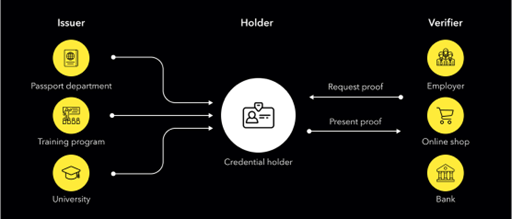
Source: Dashdevs [lxxx]
DIDs are key for enabling IoT device sensor identification and authentication by providing devices with secure self-network authentication establishing dependable data transfer while minimizing IoT system vulnerabilities. The system enhances security through encryption together with zero-knowledge proofs[lxxxi] to enforce the privacy of data throughout authentication as well as transaction operations. The dispersed system layout minimizes identity theft because malicious actions cannot strike single database targets over traditional single-point storage. The hash functions in the blockchain maintain the fixed protection of these identity cryptographically generated values, making sure that the identity's values were recorded and protected in an immutable fashion.
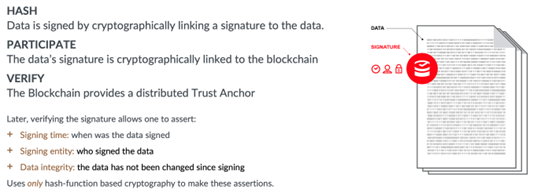
Source: Guardtime
The Linux Foundation, [lxxxii] a non-profit organization enabling mass innovation through open source, has introduced the AGNTCY.org project [lxxxiii], an open-source infrastructure that enables identity, messaging, and observability among AI agents from different vendors and frameworks. A collaboration layer lets multi-agent systems work together regardless of origin or where they run. Proliferation of AI agents will increase fragmentation and vendor silos, impeding the ability for agents to securely communicate and share context across platforms whether in public clouds, private data centres, the edge, or on devices, therefore establishing open standards for agentic interoperability.
Open Source and Sovereign AI
Open source allows AI code, models, and training content to be publicly available under permissive licenses. The term "open-source AI' means users can modify and share both the original and modified versions. When paired with sovereign AI principles, this approach gives organizations full control over data, systems, and compliance. This is a good approach for small nation-states wishing to adopt sovereign AI. Switzerland has a unique position in the global AI ecosystem, with established research foundations and robust data privacy laws. Switzerland's decentralized approach to governance makes it a reliable sandbox for testing and scaling sovereign AI solutions. UAE, Singapore, and India are building sovereign tools on top of open-source AI such as Llama [lxxxiii] to build specialized nation-focused models.
Deploying open-source AI on-premises or in private clouds keeps models and data within local jurisdiction. The open-source philosophy has started to dominate the AI space, offering transparency and community‑driven innovation, but needs investment in skills and infrastructure. The alternative is proprietary AI but limits sovereignty at a higher cost. Hybrid models can combine open community development with the robustness of vendor solutions.
Open‑source models offer deep customisation so nations can re‑engineer architectures, integrate domain‑specific data, and deploy models in private environments. Nations handling sensitive information (health records, financial transactions, classified data) require on‑premises deployment. Open‑source AI allows models to run locally while proprietary models process data in a vendor’s environment or on‑premise/private cloud deployments. Open ecosystems like Hugging Face [lxxxiv] and GitHub [lxxxv] encourage collaboration. Proprietary ecosystems integrate deeply with hyperscaler products which streamlines workflows but increases single provider dependence.
China’s strategy of releasing open‑source models to lower costs and gain market share, alongside initiatives in Europe and the U.S. to develop sovereign computing resources, indicates geopolitics will shape the availability and distribution of AI models. In the AI context, full openness includes the model architecture, how data flows through the network. Few models meet this gold standard. Achieving low latency and high uptime demands dedicated hardware and expertise.Nations must manage updates and security patches themselves. Proprietary AI models are owned by vendors who control the codebase, training data, and distribution. Access is typically provided through subscription licences or APIs such as Open AI.
Open source GPTs are blueprints on which a government can build sovereign AI without having to underwrite all of the model training costs. Open data also is growing in prominence such as Data Provenance Explorer [lxxxvi] , a large-scale collection of audited data repositories that help to build AI systems with greater transparency. A nation-state creating its own GPT runs technological risk. If an incorrect decision is made about software or a particular hardware configuration, the project may fail. The Trusted AI Alliance advocates consideration of a federation of GPTs, [lxxxvii] where resources required to build independent GPTs are shared across several nations, with private sector assistance, but the key decisions about sovereignty are controlled by government, not by individual large technology companies. Open-source code projects and open data repositories provide a code base and training data set that have been reviewed and vetted by teams of independent experts. Many non-aligned nations are looking for an alternative to U.S.- or China-centric AI ecosystems.
Future Developments
The NVIDIA body of work has pioneered high-power computing, so it is a significant player for nations investing in sovereign AI [lxxxviii]. Their sovereign AI whitepaper [lxxxix] clarifies that national AI strategies succeed or fail based on the quality of data infrastructure. Since 2019, their AI Nations initiative [xc] has helped countries build sovereign AI capabilities, including ecosystem enablement and workforce development. IDC predicts that by 2028, the spending on AI infrastructure globally will surpass $100 billion [xci], and over the next five years, the compound annual growth rate of spending on AI infrastructure will grow by 20 percent in Asia, 16 percent in the U.S., and 13 percent in Europe, the Middle East and Africa (EMEA) [xcii].
As AI continues to grow, nations face the decision of relying on AI models developed in other nations or directing their own technological future. Many are choosing the latter. Data sovereignty dictates that data should be governed by the rules and regulations in the region where it’s generated, collected, and stored. This includes what data is being used to train AI models.
Keeping AI models in-country also allows for increased control over security parameters and data privacy and can be tailored to national security needs. This is especially important as Gartner predicts that by 2027, 40 percent of data breaches will be due to cross-border misuse [xciii]. Gartner predicts that by 2027, a robust approach to data governance will be enforced by sovereign AI regulations worldwide [xciv].
The U.S. Department of Commerce is issuing licenses to NVIDIA to export its H20 chips to China (August 2025) [xcv] . The company had tailored the microprocessor for the Chinese market to comply with the U.S. AI chip export controls and will now need to pay tariffs under the new trade laws. NVIDIA said last month that its products have no back doors that would allow remote access or control after China raised concerns over security risks in the chips, but it is not clear if China will import the chips or develop domestically with Huawei.
AI will become increasingly integrated into everyday devices, enabling more natural interfaces, highly personalized experiences, and seamless automation of complex tasks. As AI systems gain greater sophistication, there will be an emergence of bilateral and multilateral agent activity where an individual’s AI agent will interact with the AI agents of governments and corporations, creating a new dynamic for the primary way in which people communicate with institutions and utility services, increasing the importance of agent identity.
Floating Data Centres
Floating data centres offer high performance, water cooling, and solar power with onboard security teams. The BlueSea Frontier Compute Cluster (BSFCC) [xcvi] is a floating vessel of NVIDIA AI chips. This raises questions about sovereign flag AI ownership of the data centre similar to the necessary use of the Liberian flag was in shipping [xcvii]. Once a data centre is in international waters, regulatory rules may not apply, leading to circumvention of sovereign AI obligations with other states. This is a developing area of note for the future.

Source: Keppel Data Centres [xcviii]
Shipping companies like Mitsui O.S.K. Lines, Ltd. are entering into agreements to develop a next-generation floating data centre platform by 2027 [xcix].
Conclusions
Sovereign AI infrastructure is emerging as a distinct asset class. Governments are building their own AI and regulating it, dovetailing state-backed capital, hyperscaler data centres, semiconductor chip production, energy generation, and fibre optic deployment, all parenthesised within geopolitics.
In 2024, global AI infrastructure spending was around $110 billion. By 2032, that figure is projected to reach $1.3 trillion annually, outperforming all other asset classes [c]. BlackRock AI Infrastructure Partnership [ci], with Microsoft, NVIDIA, and sovereign wealth funds such as the Kuwait Investment Authority [cii], is targeting long-term capital of $100 billion. Concerns have arisen that sovereign AI traps nations in isolated silos, but the aim is to develop standards so that nations get flexibility and interoperability without rewriting ab initio. Open-source frameworks and robust standard APIs are essential such as Mistral AI, Llama, and Falcon AI.
Sovereign AI is about control, but it is also about capability. Nations preparing for the next wave of AI must invest in infrastructure that treats data as a strategic asset, not just a technical IT issue. Sovereign AI is more than a trend but needs to be looked at as a commitment for sensitive data to stay in the nations and should not be confused with nationalistic withdrawal from the world markets.
AI is turbocharging innovation across every dimension of society, with a siren call to generate trillions of dollars in economic and productivity gains. Nations are using sovereign AI to harness these gains by investing in specialized hardware and new energy consumption. The global supply of the high-performance semiconductor chips required for AI operation is limited, leading to competition for these resources.
The carbon footprint of AI systems is a concern, as the high energy usage will mean more reliance on fossil fuels, potentially undermining recent gains in carbon reduction. Google recently announced it had rolled back several years of carbon mitigation gains due to rising demands on its systems from AI models. Water usage is also a factor, especially for cooling systems in data centres where AI models are trained as each query consumes a significant amount of water.
Sovereignty is not just about the AI model; it’s about the full technology stack, from servers to GPUs. Data and algorithms are as national as land and flags. A data sovereignty crisis can occur if data flows abroad and decisions made locally as healthcare systems, or economic policies could reflect algorithmic priorities of other nations and then it is too late.
Data centres in the 21st century are as ports were in the 19th century, where the cargo is now computing power. Sovereignty-as-a-service is now offered by big tech companies to nations supporting digital and AI sovereignty. Open-source AI has been described as a cornerstone of digital sovereignty [ciii] for the foundation for global autonomy and trust.
NVIDIA is front and centre to sovereign AI, yet it is a private business providing cloud services and developing AI models and is offering a sovereign AI in a box package which is being deployed in Saudi Arabia, India, and other nations. AI models have to be trained somewhere, so there will be some degree of vendor lock-in. It will be a long time before all nations are self-sufficient.
Sovereign AI is happening now, and developments will reveal partnerships that prevent hyperscaler level control in countries outside of the U.S. and China. Emerging and developing economies other than China account for 50 percent of the world’s internet users but less than 10 percent of global data centre capacity [civ]. Nations with reliable and affordable power are best positioned to unlock local computing power that is critical to homegrown AI development. In sovereign AI, data cannot be an afterthought. Whatever the future the operative word is sovereign, self-determination and autonomy.
Acknowledgements
The author would like to thank Julian Gordon of the Linux Foundation Decentralized Trust [cv] for contribution to this paper.
References
[i] United Nations Internet Governance Forum (IGF) Data and Artificial Intelligence Governance Coalition:
[ii] https://www.scientific-computing.com/article/japan-strengthens-ai-capabilities-new-nvidia-based-supercomputer#:~:text=“The%20AI%20factory%20will%20become,AI%20and%20big%20data%20applications.
[iii] https://www.nvidia.com/en-us/glossary/ai-factory/
[iv] https://en.wikipedia.org/wiki/Westphalian_system
[v] https://gdpr-info.eu/
[vi] https://en.wikipedia.org/wiki/Strategic_autonomy#:~:text=Strategic%20autonomy%20is%20defined%20as,heavily%20on%20other%20foreign%20states.
[vii] https://aicollab.org/
[viii] https://qz.com/1015698/pwc-ai-could-increase-global-gdp-by-15-7-trillion-by-2030-with-much-of-the-gains-in-china
[ix] https://www.scaleway.com/en/blog/5-key-elements-for-europe-to-achieve-sovereign-ai/#:~:text=The%20World%20Trade%20Organization%20underscores,becoming%20a%20major%20strategic%20issue
[x] https://thecuberesearch.com/
[xi] https://www.weforum.org/stories/2024/04/causal-ai-decision-making/
[xii] https://stlpartners.com/
[xiii] https://openai.com/index/chatgpt/
[xiv] https://gemini.google.com/app
[xv] https://www.reuters.com/technology/china-invests-61-bln-computing-data-center-project-official-says-2024-08-29/
[xvi] https://mistral.ai/
[xvii] https://careers.g42.ai/global/en/home
[xviii] https://www.arabnews.com/node/2602454/business-economy
[xix] https://www.capacitymedia.com/article/2ednrsm6eglrmfzs429ds/long-reads/article-inside-falcon-the-uaes-open-source-model-challenging-ai-giants
[xx] https://en.wikipedia.org/wiki/CHIPS_and_Science_Act
[xxi] https://en.wikipedia.org/wiki/CLOUD_Act
[xxii] https://ised-isde.canada.ca/site/ised/en/canadian-sovereign-ai-compute-strategy
[xxiii] https://digital-strategy.ec.europa.eu/en/policies/european-approach-artificial-intelligence
[xxiv] https://www.gov.br/g20/en/news/brasil-launches-a-usd-4-billion-plan-for-ai-and-prepares-global-action
[xxv] https://nvidianews.nvidia.com/news/tata-partners-with-nvidia-to-build-large-scale-ai-infrastructure
[xxvi] https://www.bce.ca/news-and-media/releases/show/Bell-Canada-Increases-Sovereign-AI-Capacity-with-Bell-AI-Fabric?page=1&month=&year=&perpage=25
[xxvii] https://www.telekom.com/en/media/media-information/archive/artificial-intelligence-from-the-sovereign-cloud-1093414?wt_mc=en.newsservice.en.Geschaeftskunden.250611.Link.Artificial+Intelligence+from+the+sovereign+cloud-356038236
[xxviii] https://www.telkom.co.id/sites/news-resources/en_US/news/telkom-to-deliver-ai-powered-sovereign-platform-built-with-ibm-watsonx-to-drive-ai-adoption-for-indonesian-businesses-3049
[xxix] https://openai.com/index/announcing-the-stargate-project/
[xxx] https://novonordiskfonden.dk/en/news/denmarks-first-ai-supercomputer-is-now-operational/
[xxxi] https://digital-strategy.ec.europa.eu/en/news/eu-launches-investai-initiative-mobilise-eu200-billion-investment-artificial-intelligence
[xxxii] https://notesfrompoland.com/2025/02/17/microsoft-announces-700m-investment-in-poland/#:~:text=Microsoft%20has%20announced%20a%20%24700,strengthen%20cybersecurity%20and%20boost%20competitiveness.
[xxxiii] https://www.ddn.com/
[xxxiv] https://www.cisco.com/site/us/en/solutions/artificial-intelligence/secure-ai-factory/index.html
[xxxv] https://www.mindfoundry.ai/blog/ai-regulations-around-the-world
[xxxvi] https://www.whitecase.com/insight-our-thinking/ai-watch-global-regulatory-tracker#home
[xxxvii] https://page.bsigroup.com/eu-ai-act-whitepaper?creative=714734220411&keyword=european%20regulation%20artificial%20intelligence&matchtype=e&network=g&device=c&utm_source=google&utm_medium=cpc&utm_campaign=gl-rs-ai-lg-ict-nst-nsp-mp-euaiwhitepaper-0024-ppc&utm_content=714734220411&utm_term=european%20regulation%20artificial%20intelligence&adposition=&adgroup=168002735516&gad_source=1&gad_campaignid=21740400618&gbraid=0AAAAA-IiRvae8ESphDr8D9P10Yaj3q14j&gclid=EAIaIQobChMI9Mqxy7qljwMVxQh7Bx12szyBEAAYASAAEgIU8_D_BwE
[xxxviii] https://www.eu-data-act.com/
[xxxix] https://www.europarl.europa.eu/thinktank/en/document/EPRS_BRI(2021)689333
[xl] https://www.eiopa.europa.eu/digital-operational-resilience-act-dora_en
[xli] https://e-estonia.com/cybernetica-post-quantum-cryptography-joins-to-menu/
[xlii] https://www.construction-physics.com/p/how-to-build-an-ai-data-center
[xliii] https://www.iea.org/energy-system/buildings/data-centres-and-data-transmission-networks
[xliv] https://www.cio.com/article/3808734/5-reasons-the-enterprise-data-center-will-never-die.html
[xlv] https://www.datacenterdynamics.com/en/news/singapore-lifts-data-center-moratorium-but-sets-conditions/
[xlvi] https://mcigroup.my/top-news/malaysia-launches-regions-first-sovereign-full-stack-ai-infrastructure/
[xlvii] https://mdec.my/
[xlviii] https://en.wikipedia.org/wiki/Sun_Modular_Datacenter
[xlix] https://www.sify.com/data-centers/china-launches-worlds-first-ai-powered-underwater-data-centre/
[l] https://www.iea.org/energy-system/buildings/data-centres-and-data-transmission-networks
[li] https://www.ib.barclays/our-insights/ai-revolution-meeting-massive-infrastructure-demand.html
[lii] https://about.bnef.com/insights/clean-energy/amazon-is-top-green-energy-buyer-in-a-market-dominated-by-us/
[liii] https://www.world-nuclear-news.org/articles/amazon-invests-in-x-energy-unveils-smr-project-plans#:~:text=Amazon%20has%20announced%20it%20has,in%20the%20USA%20by%202039.
[liv] https://news.microsoft.com/source/2024/05/22/microsoft-and-g42-announce-1-billion-comprehensive-digital-ecosystem-initiative-for-kenya/
[lv] https://www.datacenterdynamics.com/en/news/microsoft-signs-51mw-geothermal-ppa-in-new-zealand/
[lvi] https://www.iea.org/reports/energy-and-ai/executive-summary
[lvii] https://www.dcceew.gov.au/energy/publications/snowy-20-to-boost-australias-renewable-energy-storage-capacity
[lviii] https://generative-ai-newsroom.com/the-often-overlooked-water-footprint-of-ai-models-46991e3094b6
[lix] https://oecd.ai/en/wonk/how-much-water-does-ai-consume
[lx] https://unfccc.int/climate-action/un-global-climate-action-awards/climate-neutral-now/microsoft-carbon-negative-goal
[lxi] https://trellis.net/article/google-isnt-abandoning-its-2030-goal-despite-another-big-emissions-increase/
[lxii] https://en.wikipedia.org/wiki/Bring_your_own_encryption
[lxiii] https://www.nist.gov/image/cia-triad
[lxiv] https://www.indiatoday.in/india/story/maharashtra-cyber-cell-mumbai-power-outrage-1774522-2021-03-01
[lxv] https://iea.blob.core.windows.net/assets/34eac603-ecf1-464f-b813-2ecceb8f81c2/EnergyandAI.pdf
[lxvi] https://www.astragar.com/
[lxvii] https://www.thefastmode.com/growth-and-profitability/33752-idc-marketscape-names-crowdstrike-as-a-leader-in-worldwide-risk-based-vulnerability-management
[lxviii] https://www.adlittle.com/sites/default/files/viewpoints/ADL_Accelerating_building_energy_efficiency_2024_1.pdf
[lxix] https://www.thestandard.com.hk/market/article/306883/ASML-says-it-may-not-achieve-2026-growth-as-chipmakers-face-US-tariff-uncertainty
[lxx] https://www.tsmc.com/english
[lxxi] https://semiconductor.samsung.com/foundry/
[lxxii] https://focustaiwan.tw/business/202503150014#:~:text=TrendForce%20said%20TSMC%20commanded%20a,percent%20from%20the%20third%20quarter.
[lxxiii] https://www.scmp.com/tech/tech-war/article/3322119/china-mandates-more-domestic-ai-chips-data-centres-cut-reliance-nvidia
[lxxiv] https://developer.nvidia.com/blog/telcos-across-five-continents-are-building-nvidia-powered-sovereign-ai-infrastructure/
[lxxv] https://www.mckinsey.com/mhi/our-insights/heartbeat-of-health-reimagining-the-healthcare-workforce-of-the-future#:~:text=At%20a%20glance,global%20economy%20by%20%241.1%20trillion.
[lxxvi] https://execonline.hms.harvard.edu/artificial-intelligence-in-health-care-from-strategies-to-implementation?utm_source=Google&utm_network=g&utm_medium=c&utm_term=ai%20in%20healthcare%20course&utm_location=9198100&utm_campaign_id=21636480897&utm_adset_id=161811733850&utm_ad_id=711480059917&gad_source=1&gad_campaignid=21636480897&gbraid=0AAAAADDa9X1UBHXrqnrdg8sXLO7rEP93c&gclid=EAIaIQobChMI8drA_5GOjwMV-6RmAh0ENhtQEAAYAiAAEgL-AvD_BwE
[lxxvii] https://rienergia.staffettaonline.com/articolo/35713/Energy+for+AI,+and+AI+in+the+service+of+energy/Laura+Cozzi+(Director+of+Sustainability,+Technology+and+Outlooks,+International+Energy+Agency)+e+Alex+Martinos+(Energy+Analyst,+International+Energy+Agency)#:~:text=The%20widespread%20adoption%20of%20AI,further%20consequences%20for%20energy%20usage.
[lxxviii] https://www.coinbase.com/en-gb/institutional/research-insights/research/market-intelligence/stablecoins-new-payments-landscape
[lxxix] https://dashdevs.com/
[lxxx] https://en.wikipedia.org/wiki/Zero-knowledge_proof
[lxxxi] https://www.linuxfoundation.org/?utm_campaign=17654898-PR_AGNTCY&utm_source=PR&utm_medium=project%20announcement
[lxxxii] https://agntcy.org/
[lxxxiii] https://lama.com/
[lxxxiv] https://huggingface.co/
[lxxxv] https://github.com/
[lxxxvii] https://www.dataprovenance.org/
[lxxxvii] https://www.cirsd.org/en/horizons/horizons-summer-2024--issue-no-27/building-the-future-federation---the-rising-calls-for-sovereign-ai
[lxxxviii] https://en.wikipedia.org/wiki/Nvidia#:~:text=For%20its%20strength%2C%20size%20and,stock%20market%20in%20these%20regards.
[lxxxix] https://nvdam.widen.net/s/twmrlhsxrf/sovereign-ai-white-paper
[xc] https://www.nvidia.com/en-us/industries/global-public-sector/
[xci] https://my.idc.com/getdoc.jsp?containerId=prUS52758624
[xcii] https://www.digitalrealty.asia/resources/articles/what-is-sovereign-ai
[xciii] https://www.gartner.com/en/newsroom/press-releases/2025-02-17-gartner-predicts-forty-percent-of-ai-data-breaches-will-arise-from-cross-border-genai-misuse-by-2027
[xciv] https://www.cdomagazine.tech/aiml/ai-governance-to-be-mandatory-under-all-sovereign-ai-regulations-by-2027-gartner#:~:text=Gartner%20forecasts%20that%20by%202027,extend%20existing%20data%20governance%20frameworks.
[xcv] https://www.reuters.com/world/china/us-licenses-nvidia-export-chips-china-official-says-2025-08-08/
[xcvi] https://www.delcomplex.com/blue-sea-frontier
[xcvii] https://www.liscr.com/
[xcviii] https://www.keppeldatacentres.com/innovations/floating-data-centre/
[xcix] https://www.mol.co.jp/en/pr/2025/25061.html
[c] https://www.linkedin.com/pulse/sovereign-ai-infrastructure-becoming-next-strategic-asset-keen-e4bvc/
[ci] https://www.blackrock.com/corporate/newsroom/press-releases/article/corporate-one/press-releases/ai-infrastructure-partnership
[cii] https://www.kia.gov.kw/
[ciii] https://huggingface.co/blog/frimelle/sovereignty-and-open-source
[civ] https://www.iea.org/reports/energy-and-ai/executive-summary
[cv] https://www.lfdecentralizedtrust.org/

